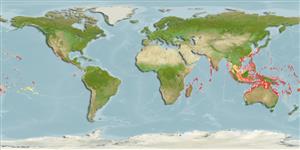Common names from other countries
Teleostei (teleosts) >
Eupercaria/misc (Various families in series Eupercaria) >
Haemulidae (Grunts) > Plectorhinchinae
Etymology: Plectorhinchus: Greek, plektos = plaited + Greek, rhyngchos = snout (Ref. 45335).
More on author: Cuvier.
Environment: milieu / climate zone / depth range / distribution range
Ecology
Marine; reef-associated; non-migratory; depth range 3 - 50 m (Ref. 9710). Tropical; 19°C - 30°C (Ref. 130624); 32°N - 32°S
Indo-Pacific: Seychelles to the Society Islands, north to Japan and south to Lord Howe and Rapa Islands. Rare or absent from most of the western Indian Ocean, but common in the Seychelles (Ref. 9710).
Size / Weight / Age
Maturity: Lm ? range ? - ? cm
Max length : 84.0 cm TL male/unsexed; (Ref. 9710); common length : 70.0 cm SL male/unsexed; (Ref. 37816)
A solitary species (Ref. 9710) found in lagoon and seaward reefs. Adults usually under coral heads or in caves, while juveniles are found in shallow lagoons. Feeds on crustaceans and mollusks. Generally marketed fresh (Ref. 5284).
Life cycle and mating behavior
Maturities | Reproduction | Spawnings | Egg(s) | Fecundities | Larvae
Oviparous, distinct pairing during breeding (Ref. 205).
Myers, R.F., 1991. Micronesian reef fishes. Second Ed. Coral Graphics, Barrigada, Guam. 298 p. (Ref. 1602)
IUCN Red List Status (Ref. 130435)
CITES (Ref. 128078)
Not Evaluated
Threat to humans
Harmless
Human uses
Fisheries: commercial; aquarium: public aquariums
Tools
Special reports
Download XML
Internet sources
Estimates based on models
Preferred temperature (Ref.
115969): 24.6 - 29, mean 27.8 (based on 844 cells).
Phylogenetic diversity index (Ref.
82804): PD
50 = 0.5000 [Uniqueness, from 0.5 = low to 2.0 = high].
Bayesian length-weight: a=0.01148 (0.00755 - 0.01746), b=3.03 (2.90 - 3.16), in cm Total Length, based on LWR estimates for this species & Genus-body shape (Ref.
93245).
Trophic level (Ref.
69278): 3.9 ±0.61 se; based on food items.
Resilience (Ref.
120179): Medium, minimum population doubling time 1.4 - 4.4 years (K=0.18).
Fishing Vulnerability (Ref.
59153): Moderate to high vulnerability (50 of 100).
